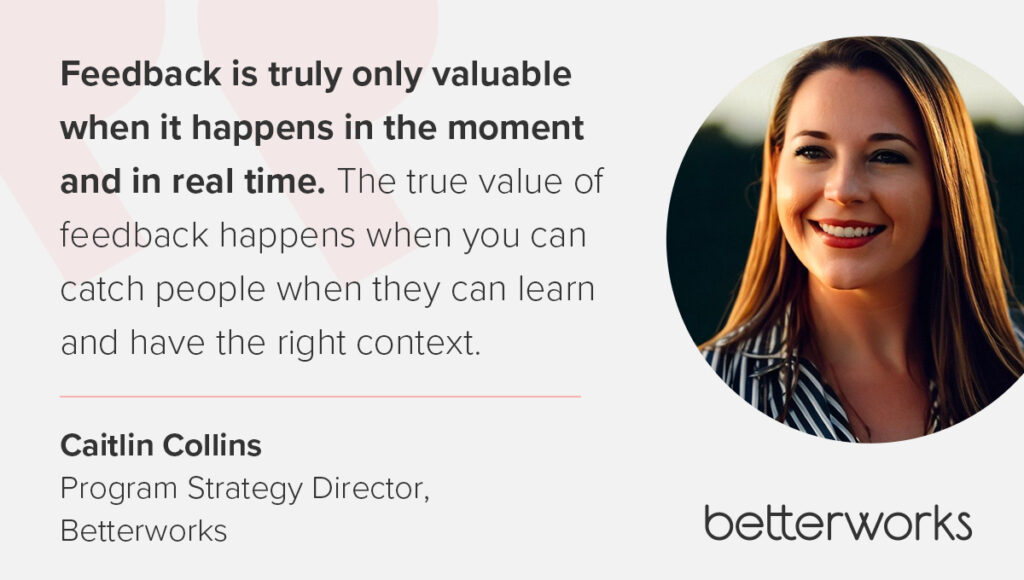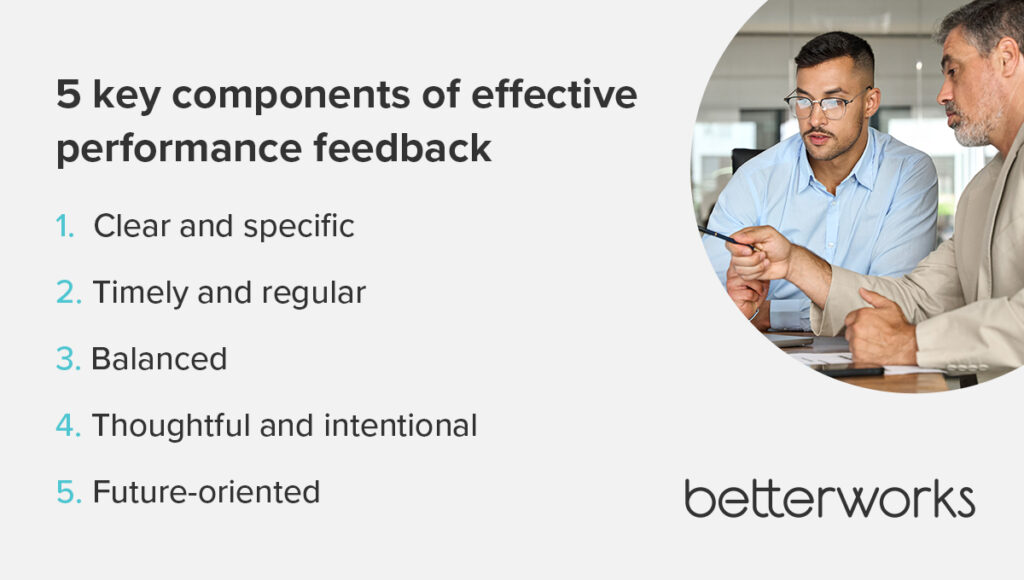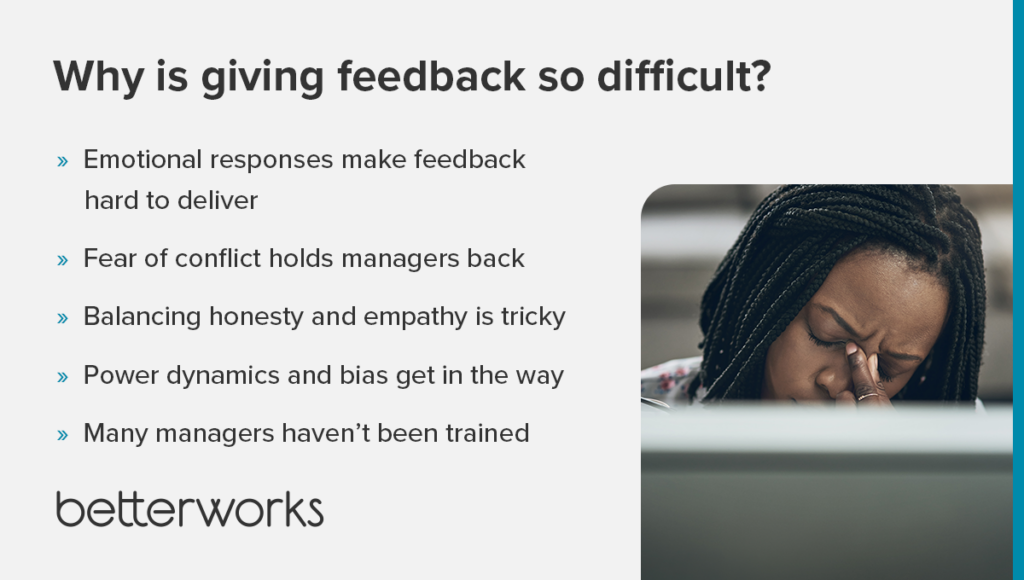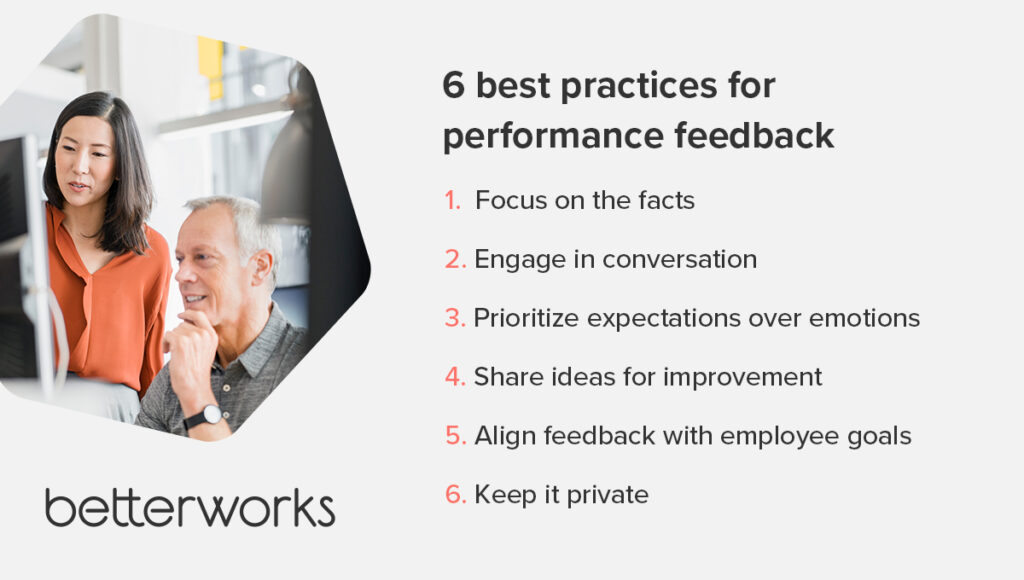- How to give feedback that actually helps
- 5 key components of effective performance feedback
- Why is giving feedback so difficult?
- 25 examples of effective performance feedback
- Timely feedback
- Constructive feedback
- Positive reinforcement
- Future-oriented feedback
- Behavior-specific feedback
- Encouraging improvement
- Recognizing strengths
- Addressing weaknesses
- Providing clear examples
- Two-way communication
- Clear goal setting
- Empathetic feedback
- Encouraging learning
- Recognizing contributions
- Praising teamwork
- Future development
- Feedback on feedback
- Acknowledging improvement
- Celebrating success
- Encouraging initiative
- Highlighting positive impact
- Providing support
- Reinforcing positive behavior
- Addressing specific issues
- Encouraging growth
- How is employee feedback best given?
- 6 best practices for performance feedback
- How can employees use feedback?
- Elevating performance feedback practices
Performance feedback is one of the most powerful tools a manager has – and one of the most underused. Feedback has the potential to build trust, improve performance, and guide career growth. When delivered effectively, employee performance feedback provides a clear path for team members to improve their performance, achieve their goals, and grow their careers.
But in too many organizations, feedback is inconsistent, unclear, or missing altogether. More than half (54%) of employees responding to our 2025 State of Performance Management report state that they don’t feel like their performance is being enabled by managers, through structured goal setting, regular feedback, or high-impact career conversations.
The widespread absence of effective performance feedback gives you the opportunity to fill the gap and set your organization apart. Discover what makes feedback effective, and check out these employee performance review feedback examples and best practices to inspire a culture of feedback in your organization.
How to give feedback that actually helps
Giving employee feedback shouldn’t be awkward, but for many managers, it is. Without the right approach, feedback can come across as vague, harsh, or just unhelpful. That’s why it’s important to make feedback timely, specific, and rooted in a desire to help employees grow.
Learn practical tips for giving feedback that builds trust, drives performance, and supports employee development without stress.
5 key components of effective performance feedback
Fostering a culture of continuous improvement and employee growth is crucial for organizational success. Performance feedback plays a key role in this effort, empowering individuals and teams to reach their full potential. Let’s explore five key components of effective performance feedback that can transform ordinary evaluations into powerful catalysts for growth and success.
Clear and specific
Clarity is key to effective performance feedback. You want employees to know exactly what’s expected of them, and how they measure up against those expectations. “Providing somebody with vague feedback does them no good,” says Caitlin Collins, organizational psychologist and program strategy director at Betterworks. “You want to give them very specific context for what you’re telling them.”
Adding concrete examples to feedback helps make it clear and tangible. By using real-life instances, employees will better understand their strengths and areas for improvement. This approach allows them to develop targeted growth strategies.
It’s also crucial to be clear about what employees need to do differently or how to improve. Set clear goals and expectations, outline the desired outcomes, and provide guidance on the steps to achieve them. By following these principles, managers can deliver performance feedback that is clear, understandable, and effective in driving both employee growth and organizational success.
Timely and regular
Timely feedback plays a crucial role in effective performance management. When managers deliver feedback promptly after observing behavior or performance, the message stays immediate and relevant. “Feedback is truly only valuable when it happens in the moment and in real time,” Caitlin says. “The true value of feedback happens when you can catch people when they can learn and have the right context.”
Continuous feedback allows employees to make adjustments right away, reinforcing good behaviors and addressing areas for improvement while the memory is fresh. Scheduling recurring performance discussions ensures that employees receive ongoing guidance, recognition, and opportunities for growth. This practice fosters a culture of open communication and trust, nurturing a growth mindset and a commitment to continuous improvement.

Balanced
Balanced feedback is crucial for effective performance management. Managers need to strike the right mix between positive reinforcement and constructive criticism to foster comprehensive employee development.
Positive feedback boosts motivation, celebrates achievements, and reinforces desirable behaviors. It cultivates a culture of appreciation, nurtures morale, and promotes a sense of accomplishment among your team.
However, Caitlin says, positive feedback alone doesn’t benefit employees. Constructive feedback provides a clear path for self-improvement. It helps employees identify areas that need development and offers the guidance necessary to elevate their performance. Addressing weaknesses directly paves the way for sustained growth.
Thoughtful and intentional
Delivering feedback with care and consideration cultivates a positive work environment where employees feel valued, supported, and motivated to excel. To create a nurturing work environment, managers need to be thoughtful about what they say and intentional about the outcome of employee conversations and reviews.
Caitlin says a system like Betterworks captures performance data in real-time, enabling managers to bring unbiased, objective observations to feedback sessions. Once equipped with data showing trends in employee performance, managers can set clear goals for performance improvement.
Future-oriented
Effective performance feedback always looks toward the future to improve employee performance, Caitlin says. Future-oriented feedback guides employees in identifying areas for development that will prepare them for future roles and challenges and encourages them to think about their growth within the company.
This approach also helps you identify and develop future leaders. By providing feedback that emphasizes potential and growth, you can help high-potential employees – as well as the hidden gems in your workforce – reach their full potential and prepare for leadership roles. This benefits the organization by providing a strong pipeline of future leaders and gives employees opportunities to advance their careers.

Why is giving feedback so difficult?
Many managers face emotional, interpersonal, and skill-related barriers when giving feedback:
- Emotional responses make feedback hard to deliver. Managers worry about triggering defensiveness or hurting feelings, which can lead to unclear or softened messages.
- Fear of conflict holds managers back. Concern about damaging relationships can cause managers to avoid feedback or make it too vague to be useful.
- Balancing honesty and empathy is tricky. Managers want to be both candid and kind, but finding the right words isn’t always easy.
- Power dynamics and bias get in the way. Past experience and unconscious bias can affect how feedback is delivered and received.
- Many managers haven’t been trained. Without feedback training, it’s hard to be clear, specific, and constructive in difficult conversations.

25 examples of effective performance feedback
Giving clear, actionable feedback is one of the most important parts of performance management, but it’s not always easy to get right. These employee feedback examples can help managers and team members deliver meaningful input that supports growth, builds trust, and drives results.
Whether you’re offering praise or addressing a challenge, use these performance management examples to guide your conversations.
Timely feedback
Feedback example: “I noticed you handled the client meeting really well yesterday. Your clear communication helped the client understand our proposal better. Keep up the good work!”
Why it’s effective: This feedback is timely and provided immediately after the meeting, which reinforces positive behavior while it’s still fresh in the employee’s mind.
Constructive feedback
Feedback example: “During the team presentation, you seemed to struggle with the new software. Let’s schedule some training to help you get more comfortable with it.”
Why it’s effective: This feedback identifies a specific issue and offers a solution, making it constructive and actionable.
Positive reinforcement
Feedback example: “Great job on the project report! Your detailed analysis was impressive and very helpful for our planning.”
Why it’s effective: This feedback specifically acknowledges the employee’s strong analytical skills, reinforcing positive behavior and boosting morale.
Future-oriented feedback
Feedback example: “You did a fantastic job managing the team on this project. I see potential in you for a leadership role. Let’s discuss how we can develop your management skills further.”
Why it’s effective: This feedback praises current performance and provides a clear path for aligning skill growth with performance excellence.
Behavior-specific feedback
Feedback example: “I noticed you interrupted a few colleagues during the meeting. I love how excited you are! Perhaps next time, try to listen fully before responding. It will help improve the flow of discussion.”
Why it’s effective: This feedback focuses on specific behavior, making it clear and actionable for the employee to improve.
Encouraging improvement
Feedback example: “Your last presentation was much better than the previous ones. Keep working on your pacing, and you’ll continue to improve.”
Why it’s effective: This feedback acknowledges improvement while providing a specific area for further development, encouraging ongoing career growth.
Recognizing strengths
Feedback example: “Your ability to stay calm under pressure is a great asset to our team. It really helps us navigate tough situations effectively.”
Why it’s effective: This feedback highlights a key strength, reinforcing the employee’s confidence and encouraging continued use of this valuable skill.
Addressing weaknesses
Feedback example: “I appreciate how much effort you put into the client proposal. Your hard work did not go unnoticed. I have some suggestions for how you can make your presentations even more impactful.”
Why it’s effective: This feedback recognizes and values the employee’s effort, boosting morale and motivation.
Providing clear examples
Feedback example: “In our last meeting, your suggestion to streamline the process was spot on. It saved us a lot of time.”
Why it’s effective: This feedback uses a specific example to illustrate the positive impact of the employee’s contribution, making it clear and meaningful.
Two-way communication
Feedback example: “How do you feel about the feedback I provided? Is there anything you’d like to discuss or clarify?”
Why it’s effective: This feedback invites dialogue, making the process collaborative and ensuring mutual understanding.
Clear goal setting
Feedback example: “To improve your project management skills, let’s set a goal to complete a project from start to finish independently within the next quarter.”
Why it’s effective: This feedback sets a clear, achievable goal, providing direction and motivation for the employee’s development.
Empathetic feedback
Feedback example: “I understand the last few weeks have been challenging. Let’s discuss how we can help you complete tasks more effectively moving forward.”
Why it’s effective: This feedback shows empathy and offers support, fostering a supportive and understanding work environment.
Encouraging learning
Feedback example: “I see you’ve been struggling with the new software. I recommend taking the upcoming training session to improve your skills.”
Why it’s effective: This feedback identifies a problem and provides a specific solution, encouraging skill development.
Recognizing contributions
Feedback example: “Your insights during the strategy meeting were invaluable, and will help us achieve our goals this quarter.”
Why it’s effective: This feedback acknowledges that the employee’s contributions exceeded expectations, reinforcing positive behavior and engagement.
Praising teamwork
Feedback example: “Your collaboration with the marketing team on the recent campaign was excellent. It showed great teamwork.”
Why it’s effective: This feedback highlights and reinforces behaviors that led to team performance, promoting a collaborative work culture.
Future development
Feedback example: “You’ve done well in your current role. Let’s discuss opportunities for you to take on more responsibilities.”
Why it’s effective: This feedback acknowledges current success and provides a pathway for future growth, motivating the employee.
Feedback on feedback
Feedback example: “How did you feel about the feedback I gave you last week? Was it helpful?”
Why it’s effective: This feedback asks for the employee’s feedback on the performance review and its effectiveness, fostering a culture of continuous improvement and demonstrating that the manager cares about the employee’s perspective.
Acknowledging improvement
Feedback example: “I’ve seen a lot of improvement in your customer interactions. Keep up the good work.”
Why it’s effective: This feedback recognizes and encourages continued improvement, boosting the employee’s confidence and motivation.
Celebrating success
Feedback example: “Congratulations on closing the deal! Your negotiation skills were top-notch.”
Why it’s effective: This feedback celebrates a specific achievement, reinforcing positive behavior and success.
Encouraging initiative
Feedback example: “I appreciate your initiative in taking on the new project. It’s great to see you stepping up.”
Why it’s effective: This feedback recognizes and encourages proactive behavior, promoting a culture of initiative.
Highlighting positive impact
Feedback example: “Your work on the sustainability project has had a significant positive impact in helping us reach our strategic business goal to reduce our waste stream. Well done!”
Why it’s effective: This feedback highlights the positive business impact of the employee’s work, reinforcing its strategic importance and value.
Providing support
Feedback example: “I see you’re struggling with the workload. Let’s prioritize your tasks together to make them more manageable.”
Why it’s effective: This feedback offers support and a practical solution, helping the employee manage their workload effectively.
Reinforcing positive behavior
Feedback example: “Your punctuality has improved significantly. Keep it up!”
Why it’s effective: This feedback acknowledges and encourages continued positive behavior, reinforcing good habits.
Addressing specific issues
Feedback example: “I’ve noticed you’ve been missing a lot of deadlines lately. Let’s discuss what’s going on and how we can address it.”
Why it’s effective: This feedback addresses a specific issue and seeks to understand the root cause, promoting constructive problem-solving.
Encouraging growth
Feedback example: “You have a lot of potential in project management. Let’s set up a mentorship program to help you develop these skills.”
Why it’s effective: This feedback identifies potential and offers a clear path for development, motivating the employee to grow.
How is employee feedback best given?
Employee feedback is typically delivered through structured conversations between managers and employees, or between employees and their peers, often during regular check-ins, performance reviews, or informal coaching moments. Effective feedback is timely, specific, and focused on behaviors rather than personality traits.
It’s best delivered in a private, two-way conversation, where the employee has space to reflect, respond, and ask questions. Using a consistent framework – such as identifying what went well, what could improve, and how to move forward – helps ensure the feedback is clear, actionable, and supportive of the employee’s development. Tools like Betterworks, which provide AI for performance reviews, help coach managers through the feedback process with real time suggestions.
6 best practices for performance feedback
Effective performance evaluations and feedback drive higher employee engagement, empowering team members to take their performance to the next level. By equipping managers with the right skills and techniques for delivering feedback, you can foster a culture of continuous improvement and development within the organization.
Focus on the facts
Objective feedback builds trust and encourages action. “Feedback is really valuable when it is objective and learning-oriented,” Caitlin says. Instead of vague or personal comments, managers should describe observed behaviors and their impact. For example: “I noticed you didn’t collaborate on the last project, which caused delays” is far more constructive than “You’re not a team player.” Be specific and focus on performance, not personality to keep feedback fair and actionable.
Engage in conversation
Managers should invite input, ask open-ended questions, and listen actively. “Feedback in and of itself should be conversational,” Caitlin says. For example: “What challenges did you encounter during the project?” This makes feedback a shared experience rather than a one-sided critique. Make the conversation two-way and be empathetic. Understanding the employee’s perspective increases clarity and buy-in.

Prioritize expectations over emotions
When feedback is anchored in expectations, not feelings, it’s easier to digest. “A really easy way to cut through the emotional complexities is just to start at an objective level,” Caitlin says. Focus on outcomes, not emotion: “The project missed the deadline,” not “I’m disappointed in you.” This keeps conversations focused and keeps it private, especially when addressing sensitive topics.
Share ideas for improvement
Feedback should offer a path forward. “It’s meant to be a gift,” Caitlin says. Provide actionable suggestions like, “Try a daily task list to prioritize work,” instead of vague advice like “Be better at time management.” Tailor your suggestions to what’s relevant and helpful. Feedback should lead to clear next steps, not confusion.
Align feedback with employee goals
Creates a sense of purpose and direction for employees. “When people are empowered to use feedback, to use coaching, to use goals to drive their own performance, that’s where organizations can really be competitive,” Caitlin says. Connect feedback to what the employee wants to achieve. For instance, recommend leading a team meeting to develop leadership skills. This creates a more motivating and meaningful feedback experience.

How can employees use feedback?
Employees can use feedback as a tool for growth, clarity, and professional development. By reflecting on the input, identifying patterns, and asking follow-up questions, they can turn feedback into specific actions, such as improving a skill, adjusting behaviors, or aligning effort more closely with team goals.
Feedback also helps employees understand how their work is perceived and where they can make the biggest impact. Tools like Betterworks Feedback support employee growth by giving them a window into where they stand in the organization, and where they have opportunities to grow. When paired with goal setting or a development plan, it becomes a powerful driver of both individual performance and career progression.
Elevating performance feedback practices
Effective performance feedback drives business success and employee engagement by providing clear, actionable insights that empower individuals and teams to reach their full potential. Regular feedback on employee performance, combined with clearly communicated performance goals, significantly improves individual performance and drives business outcomes.
Implementing best practices for performance feedback fosters a culture of continuous improvement and open communication. This culture not only enhances employee growth but also aligns individual goals with organizational objectives, creating a more motivated and cohesive workforce. By equipping managers with the skills to deliver effective feedback, you can empower feedback sessions as valuable opportunities for development, ultimately driving business success and fostering a positive, growth-oriented work environment.
Promote better feedback



